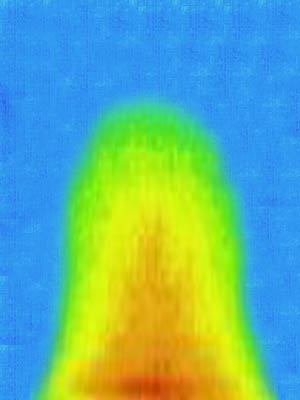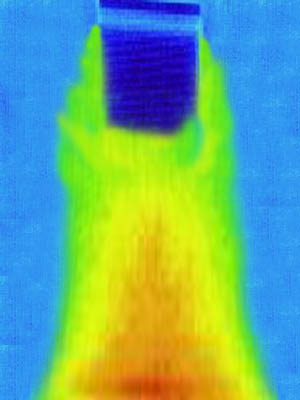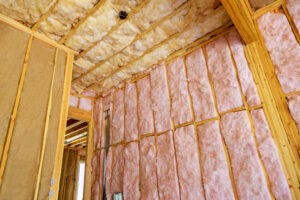Fixing a heat register under a window
Last updated on March 10th, 2024 at 03:33 pm
One of the most challenging problems for homeowners is with the placement of a heat register, radiator or other heat source under or near a window. The problem is compounded with every degree the temperature plummets outside.
Understanding the problem
To figure out how to fix the problems, we have to understand what is going on. Warmed air always rises (and conversely cold air falls). Since warmed air will always rise from the heat source it will gravitate upwards. Under most circumstances, when a heat register is on a wall, the warmed air mixes with the room air and rises up the wall. In most houses, this leads to a “cone” heat signature:

Now this is assuming very little air circulation. Notice how the heat simply creeps up the wall and refuses to spread? The wall is actually absorbing the heat. We know this because the entire wall isn’t being warmed. It remains a cool blue – which is our base temperature. Eventually, it disspates.
Now, let’s add a window.

We can see that the heat envelopes the window, heating both it and the frame. When this happens, heat is being lost. The warmed air in contact with the cold surface will readily promote heat loss. The areas of greatest heat loss will be at the intersection of the coolest colors with the warm colors…in other words around the window.
Most of the time, windows and their frames insulate well (when they are newer or just insulate better because of materials).When there is a heat source near them though, much warmer air warms the surface we lost heat.
You may be wondering about oil heaters. The problem isn’t as bad as with forced air systems as long as there is sufficient air circulations around the coils/pipes. Forced air pushes the heated air towards the window most of the time.
When this happens, the window may more readily freeze shut or cause ice jams. This makes it near impossible to open the window. Also, ice may form inside the house, as ice will melt when in contact with the frame, but refreeze readily when the heat is down or off. This damages the wall, window frame, floor, and possibly the wires behind the wall.
A common symptom of a poorly insulated window near a heat source is frozen condensation inside the house on the window pane. If this happens, it means the air around the window is heated, but so much heat is being lost through the pane/frame that the water vapor near the window freezes.
So…how do you fix it?
This is a two step process.
First, you have to deflect the heat away from the window. Most houses do not have heat vents near outer facing walls, however, some certainly will. It seems to be a problem for bigger rooms that require more heat registers, or older homes with failing windows.
The most common course of action is a heat deflector at home depot or lowes for about $5 bucks. They are magnetized and will readily attach to most registers. You can also try placing an object between the wall and register to prevent the creep upwards towards the window. (Remember, heat will want to move towards cooler areas naturally. And the colder the area, the fast the heat will transfer, until it reaches a constant temperature. More on this in a bit.) You can also try increasing the circulation of the air when it is in the room via the deflector. Ceiling fans and just plain movement is good for this.
The second thing you’ll want to do is minimize the heat loss by insulating the window. Insulating plastic is nice, storm windows are good, and caulking gaps and cracks are excellent. If you find you have faulty window panes, insulating plastic or insulation film may help. Replacing the windows is the best option.
This is important because the heated air in your home will move faster towards colder windows, and be lost faster. Heated air mixes with the other air in your house until it reaches equilibrium. Think of it as a milkshake in a blender. You put in cold ice cream, milk, some fruit or vanilla, etc. All the ingredients have a different consistency, different temperatures, textures, flavors, etc. A blender mixes everything until it reaches a constant temperature, a constant thickness. Think of that as equilibrium. The air in your home is the same way. It wants everything to be the same temperature, and will mix until it reaches. And when this happens around a leaky window, heat is lost. The room will never reach equilibrium point because cold air is constantly coming in, and warm air is escaping.


